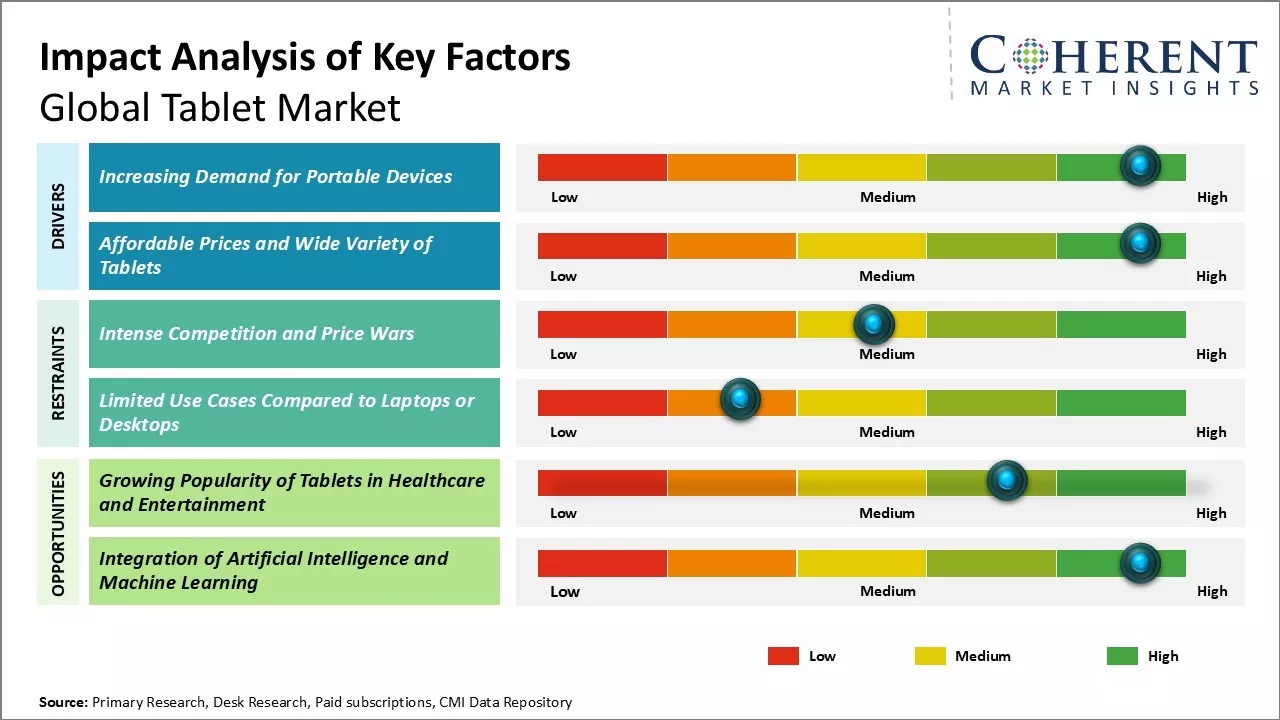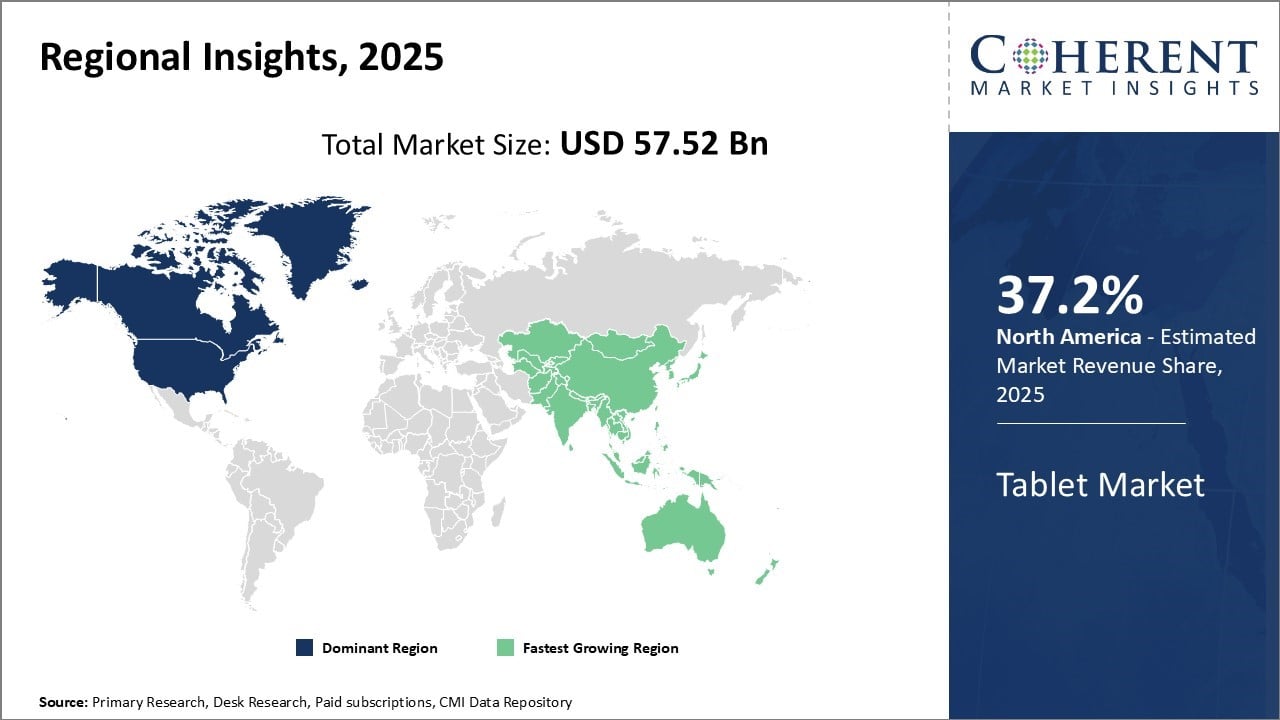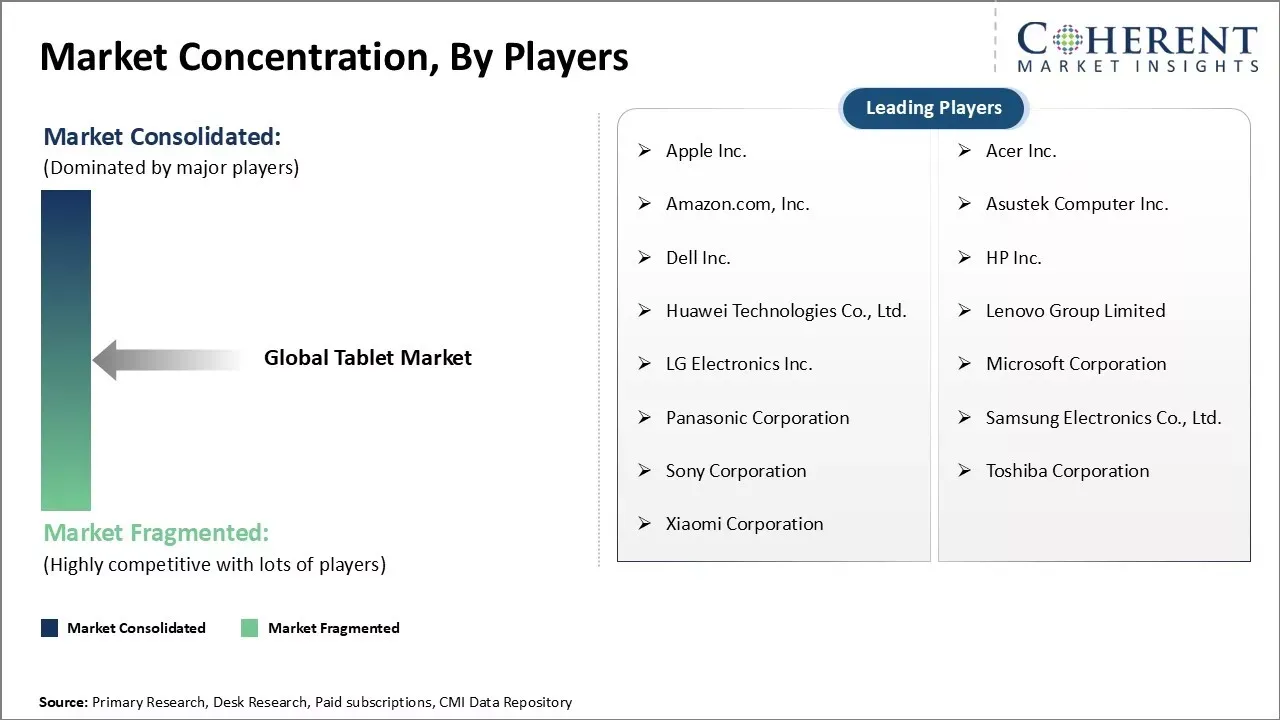
The Global Tablet Market is estimated to be valued at USD 57.52 Bn in 2025 and is expected to reach USD 75.24 Bn, exhibiting a compound annual growth rate (CAGR) of 3.9% from 2025 to 2032.

To learn more about this report, Download Free Sample
Tablets have seen consistent growth over the past decade with improved features and falling prices. The category has now moved beyond personal usage and entered applications such as education, healthcare, retail, and more. Lower costs and versatile form factors compared to notebooks and laptops will continue aiding tablet adoption globally.
|
Current Events |
Description and its impact |
|
Geopolitical Trade Policies and Tariff Uncertainties
|
|
|
Supply Chain Disruptions and Logistics Challenges |
|
|
Regulatory and Environmental Pressures |
|
Uncover macros and micros vetted on 75+ parameters: Get instant access to report
Artificial Intelligence (AI) transforms the tablet market by actively enhancing user experience, personalizing interactions, and improving device performance. Manufacturers integrate AI to enable facial recognition, optimize battery usage, power voice assistants like Siri and Google Assistant, and adjust screen brightness dynamically. AI also drives advanced functions such as real-time language translation, predictive typing, and smart note organization. By boosting productivity tools and enabling edge computing, AI makes tablets faster, more secure, and highly adaptive for both individual and professional users.
In July 2025, Lenovo launched its powerful Yoga Tab Plus in India, now available on Amazon with a ‘Notify Me’ option. Marketed as Lenovo’s first AI-powered tablet, the device integrates indigenous Large Language Models under the Lenovo AI Now platform. Designed for both productivity and entertainment, it boasts a 3K display, Snapdragon 8 Gen 3 processor, and Harman Kardon-tuned speakers—positioning it as a premium all-in-one multimedia and work companion.
The Android segment is estimated to hold 51.7% share of the market in 2025 owing to its wide availability across a variety of tablet models and brands. Being an open-source platform, Android allows device manufacturers high levels of flexibility to customize the user interface, pre-install proprietary apps, and tweak hardware specifications as per their target audience. This has ensured its adoption across both high-end and low-cost tablets. Additionally, Android's strong third-party developer ecosystem provides users access to millions of apps and games. Its integration with Google's extensive services like Gmail, Maps and YouTube also enhances the overall user experience. For instance, in June 2025, OnePlus introduced OnePlus Pad 3—a powerful device featuring a large, vibrant display and specifications that, on paper, should meet the expectations of even the most demanding users. This is further accelerating the tablet market growth.
The 8 to 10 inches segment is estimated to hold 44% share in 2025 due to optimal balance between portability and productivity it offers. Devices in this size are highly portable for mobile use cases like travel, commute and outdoors entertainment without compromising on visibility of content and ease of typing/navigation. They can be easily held with one hand and fit into bags and backpacks. At the same time, their screen is large enough to run two apps side-by-side and perform productivity tasks like document editing, photo processing and multimedia content creation. 8 to 10 inches have emerged as the sweet spot for use both at home and on the go. For instance, Lenovo's new Legion Y700 4th Gen gaming tablet, which has an 8.8-inch display and Snapdragon 8 Elite, will be targeted by iQoo's upcoming iPad Mini.
The Consumer segment is estimated to hold 60.3% share in 2025 due to massive individual demand for tablets as a companion device. Tablets are increasingly being used by consumers for entertainment, communication, browsing, and light productivity. Their sleek design, long battery-life and wide catalogue of apps has boosted their popularity as a portable entertainment and leisure device among users of all demographics. Affordable tablets priced at entry-level have expanded the market, while premium tablets deliver flagship experiences for premium use cases like gaming and multimedia content creation. The thriving BYOD trend at workplaces has also augmented consumer adoption of tablets in place of laptops for casual tasks. Massive individual consumption remains the dominant growth engine for OEMs in this space.

To learn more about this report, Download Free Sample
Tablets continue to thrive in the North American market as consumers and enterprises increasingly use them for education, entertainment, and remote work. Schools actively invest in digital learning tools, while widespread 5G and high-speed networks fuel broader adoption. Apple maintains its lead with over 55% market share, while Samsung and Amazon compete closely. As the market matures and replacement cycles grow longer, OEMs respond by introducing hybrid designs, foldable displays, and eco-friendly manufacturing to drive renewed interest and differentiation. For instance, in April 2025, Motorola launched its new three-tiered motorola razr lineup in North America, which includes the motorola razr ultra, motorola razr+, and motorola razr. With intelligent AI features and a next-generation iconic design, the new razr series offers a bolder, smarter, and more personalized mobile experience.
Governments and educational institutions across Asia Pacific are actively investing in tablets to support online education. Countries like China, India, and Indonesia are distributing tablets to students through various e-learning initiatives. Consumers across the region prefer affordable Android tablets from brands like Lenovo, Xiaomi, Realme, and Huawei, especially in developing nations. These budget-friendly devices dominate rural and semi-urban markets, as cost-conscious users increasingly choose them for their practicality, accessibility, and compatibility with educational and entertainment needs. For instance, in July 2025, RedMagic launched the Tablet 3 Pro in China, showcasing a 9.06-inch display with uniform 4.9mm bezels. The device features an impressive 1504x2400px LTPO OLED panel with a 16:10 aspect ratio, offering a peak refresh rate of 165 Hz, HDR support, PWM dimming, and a maximum brightness of 1,600 nits. This is further proliferating the tablet market share in APAC region.
Indian consumers are increasingly choosing Android tablets due to their wide availability and affordability. Brands like Lenovo, Xiaomi, and Realme actively cater to students, families, and first-time users in semi-urban and rural regions seeking reliable devices for online learning, entertainment, and browsing. At the same time, tech-savvy users and urban professionals are showing growing interest in premium models from Apple, Samsung, and OnePlus, driving a gradual shift toward high-performance and productivity-oriented tablets. For instance, in June 2025, Lenovo India expanded its Android tablet lineup with the launch of the Lenovo Yoga Tab Plus. Recently spotted on Amazon India, the tablet will feature Qualcomm's flagship 4nm Snapdragon 8 Gen 3 processor, paired with UFS 4.0 storage and 16GB of LPDDR5X RAM.
Consumers in the United States increasingly use tablets for remote productivity, online learning, and virtual collaboration. High-speed internet and widely used educational apps drive adoption across homes, schools, and workplaces. American users enjoy tablets for streaming, gaming, and managing smart homes. As tablets evolve into hubs for IoT and automation, their role shifts from content consumption to device control. To capture attention in a maturing market, vendors actively differentiate their products through eco-friendly materials, business-oriented features, and a range of accessories. For instance, in March 2025, Samsung unveiled a new rugged Android tablet in the US, powered by the Exynos 1380 chipset—the Galaxy Tab Active5. Both the standard and Pro models seem to feature 6 GB of RAM, but Samsung is also expected to introduce an 8 GB variant with 128 or 256 GB of internal storage. Such innovations are propelling the tablet market revenue in United States.

To learn more about this report, Download Free Sample
| Report Coverage | Details | ||
|---|---|---|---|
| Base Year: | 2024 | Market Size in 2025: | USD 57.52 Bn |
| Historical Data for: | 2020 To 2024 | Forecast Period: | 2025 To 2032 |
| Forecast Period 2025 to 2032 CAGR: | 3.9% | 2032 Value Projection: | USD 75.24 Bn |
| Geographies covered: |
|
||
| Segments covered: |
|
||
| Companies covered: |
Apple Inc., Acer Inc., Amazon.com, Inc., Asustek Computer Inc., Dell Inc., HP Inc., Huawei Technologies Co., Ltd., Lenovo Group Limited, LG Electronics Inc., Microsoft Corporation, Panasonic Corporation, Samsung Electronics Co., Ltd., Sony Corporation, Toshiba Corporation, and Xiaomi Corporation |
||
| Growth Drivers: |
|
||
| Restraints & Challenges: |
|
||
Uncover macros and micros vetted on 75+ parameters: Get instant access to report
Educational institutions and governments are increasingly adopting tablets to support digital learning. Tablets are being widely deployed in schools for interactive lessons, digital textbooks, and online testing. Their portability, affordability, and compatibility with e-learning platforms make them ideal for students. This trend is especially visible in developing regions, where tablets serve as a cost-effective alternative to laptops for both students and educators, contributing significantly to the growth of the education-focused tablet segment.
The market is witnessing a growing preference for hybrid tablets that function as both laptops and touch-screen devices. These detachable tablets appeal to users who need portability without compromising on productivity. Manufacturers are integrating stylus support, improved multitasking software, and detachable keyboards to meet the needs of professionals, students, and creatives. This trend reflects users’ shifting expectations—from simple media consumption to more complex, productivity-oriented use cases that require better performance and flexibility in a single device.
The growing emphasis on digital education creates a strong opportunity for tablet manufacturers. Schools, colleges, and governments are investing in devices to support virtual classrooms, e-books, and remote learning. With increasing internet penetration and affordable data, especially in developing countries, tablets serve as ideal learning tools for students. Companies that offer durable, affordable, and education-optimized tablets—with stylus and learning apps—can capture significant demand in both urban and rural education ecosystems.
Share
Share
About Author
Raj Shah is a seasoned strategy professional with global experience, from strategy to on-the-ground operational improvements. In last 13 years, he has executed number consulting projects focused on consumer electronics, telecom and consumer-internet business leading multiple long-term engagements towards mobilizing and executing on break-through strategy - leading to tangible sales results. Raj is also acting as a strategy consultant for one of the leading online hyper local service providers in India, contributing to their growth through critical strategic decisions. Raj usually spends time after office in talking to the passionate entrepreneurs, regardless of their funding status.
Missing comfort of reading report in your local language? Find your preferred language :
Transform your Strategy with Exclusive Trending Reports :
Frequently Asked Questions
Joining thousands of companies around the world committed to making the Excellent Business Solutions.
View All Our Clients